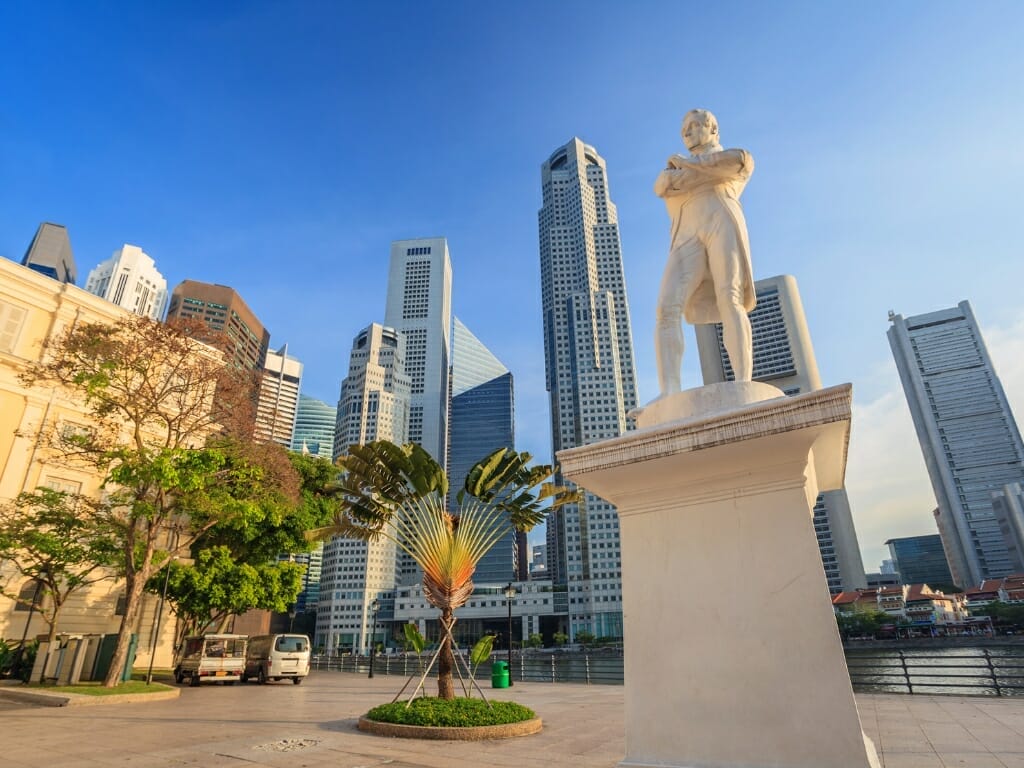9 Facts About Sir Stamford Raffles: The Man Behind Modern Singapore

No Time to Read? Here’s a Snappy Summary of This Article
- Visionary Founder: Sir Stamford Raffles transformed a small fishing village into the bustling metropolis of modern Singapore in 1819.
- Cultural Catalyst: Raffles’ interest in local languages and cultures helped shape Singapore’s vibrant multicultural identity.
- Iconic Landing Site: His arrival at the Singapore River’s mouth marked the birthplace of the nation.
- Early Adventures: Born in Jamaica, Raffles had a diverse colonial career before his pivotal role in Singapore’s history.
- Enduring Legacy: The Raffles statue near Boat Quay pays homage to his lasting impact on the island.
- Southeast Asian Influence: Raffles’ influence extended beyond Singapore, shaping British colonialism in the region.
Table of Contents
- No Time to Read? Here’s a Snappy Summary of This Article
- 1. Early Life
- 2. The East India Company
- 3. The Java Expedition
- 4. Founding of Singapore
- 5. Raffles’ Vision for Singapore
- 6. Personal Life
- 7. The Raffles Institution
- 8. Return to England and Later Years
- 9. Legacy in Modern Singapore
- Meanwhile, Check Out Tropika Club’s Ecosystem of Websites
Introduction
Sir Stamford Raffles is a name that echoes throughout the history of Singapore. As the founder of modern Singapore, his influence is felt in every corner of this bustling city-state. But who was the man behind the name? In this article, we delve into 10 fascinating facts about Sir Stamford Raffles, shedding light on the complexities and nuances of a man who shaped Singapore’s destiny.

1. Early Life
Born on July 6, 1781, in Jamaica, Sir Stamford Raffles had a humble beginning. His father was a merchant captain, and the family faced financial difficulties. Despite these challenges, Raffles showed an early aptitude for learning. His keen intellect would later become instrumental in his colonial pursuits, setting the stage for his future role in Singapore.

2. The East India Company
Raffles joined the British East India Company at the age of 14. His intelligence and dedication quickly caught the attention of his superiors. He rose through the ranks and was eventually posted to Penang, then known as Prince of Wales Island. His time there would give him insights into Southeast Asia, preparing him for his future role in Singapore.

3. The Java Expedition
In the year 1811, Sir Stamford Raffles was appointed as the Lieutenant-Governor of Java, an island in Indonesia. This marked a significant chapter in his life and career, shaping his vision for colonial governance. Raffles’ rule in Java was characterized by a series of progressive reforms that were ahead of their time. One of the most notable of these was the abolition of slavery, a practice that was prevalent in many parts of the world during that era. This decision underscored Raffles’ commitment to human rights and his belief in the inherent dignity of all people. In addition to this, Raffles also promoted the cultivation of cash crops. This was a strategic move aimed at boosting the economy of Java and improving the livelihoods of its inhabitants. The introduction of cash crops provided a steady source of income for the locals and helped to establish a more stable and prosperous society. However, Raffles’ progressive policies were not universally popular. His reforms, while beneficial in many ways, also disrupted the established order and faced resistance from certain quarters. This opposition eventually led to his recall to England, marking the end of his tenure as the Lieutenant-Governor of Java.

4. Founding of Singapore
On January 29, 1819, Raffles landed on the island of Singapore. Recognizing its strategic importance, he signed a treaty with the local rulers and established a trading post. This move would change the course of history, transforming Singapore from a sleepy fishing village into a bustling port city.

5. Raffles’ Vision for Singapore
Sir Stamford Raffles, the founder of modern Singapore, had a grand vision for the city-state. He envisaged Singapore as a key player in the global trade network, serving as a hub for free trade. This vision was not just about economic prosperity, but also about establishing Singapore as a strategic bastion against Dutch influence in the region. Raffles recognized the geopolitical significance of Singapore’s location and sought to leverage it to its full potential. Raffles’ policies played a crucial role in shaping Singapore’s unique multicultural society. He encouraged immigration, welcoming people from different parts of the world to make Singapore their home. This influx of immigrants brought with them their diverse cultures, traditions, and religions, contributing to the rich tapestry of Singapore’s multicultural society.

6. Personal Life
Raffles was married twice and had several children, although many of them died young. He was known to be a loving husband and father, but his colonial pursuits often kept him away from home. His personal life was marked by both joy and tragedy, reflecting the complexities of the man himself.
_
Read Also:
6 Things Everyone Gets Wrong About Cats
_

7. The Raffles Institution
One of Raffles’ lasting legacies in Singapore is the Raffles Institution. Founded in 1823, it is one of the oldest and most prestigious schools in Singapore. Raffles envisioned it as a place where the children of Singapore could receive a quality education, irrespective of their background.

8. Return to England and Later Years
In 1824, Sir Stamford Raffles returned to England, his health in a state of decline. Despite his deteriorating condition, he remained committed to his cause, continuing to write and advocate for colonial reform. His passion for progress and reform was undeterred by his personal circumstances, demonstrating his unwavering dedication to his vision. Until his last breath on July 5, 1826, Raffles continued to contribute to the discourse on colonial governance. His writings served as a testament to his progressive ideals and his belief in the potential of the colonies under British rule. Raffles’ contributions were not immediately recognized during his lifetime. However, his impact became increasingly evident in the years following his death. His visionary policies and progressive reforms laid the foundation for the modern city-state of Singapore, and his influence extended far beyond the shores of the island.

9. Legacy in Modern Singapore
Today, Raffles’ influence is evident throughout Singapore. From the luxurious Raffles Hotel to the numerous streets and landmarks bearing his name, his legacy is inextricably woven into the fabric of this city-state. His vision and policies have helped shape Singapore into the global powerhouse it is today.
Conclusion
Sir Stamford Raffles, the founder of modern Singapore, was indeed a man of vision and contradictions. His influence on the city-state is profound and continues to resonate in its present-day landscape. Raffles was a visionary, foreseeing the potential of Singapore as a strategic trading post. His decision to establish a British trading post there in 1819 marked the beginning of Singapore’s transformation from a small fishing village to a bustling metropolis. His vision for Singapore was not just about economic prosperity, but also about creating a society that was multicultural, inclusive, and progressive. However, Raffles was also a man of contradictions. While he championed progressive ideals such as the abolition of slavery, his approach to colonial governance was often marked by a high-handedness that disregarded the customs and traditions of the local population. His policies, while transformative, were also disruptive, leading to significant social and cultural changes. Despite these contradictions, Raffles’ influence on Singapore is undeniable. His policies laid the groundwork for Singapore’s multicultural society and open economy. His vision for the city-state continues to guide its development, shaping its policies and its global outlook. As we navigate the bustling streets of modern Singapore, it’s indeed worth reflecting on the legacy of Sir Stamford Raffles. His vision and contradictions have left an indelible mark on the city-state, influencing its history and shaping its future. His story serves as a reminder of the complexities of colonial history and the transformative power of visionary leadership.

Frequently Asked Questions (FAQ)
Q: What were Sir Stamford Raffles’ major contributions to Singapore?
A: Sir Stamford Raffles is renowned for founding modern Singapore, establishing it as a British trading post in 1819.
Q: Can you tell me more about Sir Stamford Raffles’ early life and background?
A: Raffles was born in 1781 in Jamaica and later served in various British colonies before coming to Singapore.
Q: What is the significance of Raffles’ landing site in Singapore?
A: Raffles’ landing site at the Singapore River’s mouth symbolizes the birthplace of modern Singapore.
Q: How did Raffles impact Singapore’s cultural heritage?
A: Raffles promoted the study of local languages and cultures, contributing to Singapore’s rich multicultural identity.
Q: What is the Raffles statue in Singapore, and why is it famous?
A: The Raffles statue, located near Boat Quay, honors his role in shaping the island and is a popular historical landmark.
Q: Did Sir Stamford Raffles have a lasting influence on Southeast Asia?
A: Yes, Raffles’ work extended beyond Singapore; he played a significant role in British colonialism in Southeast Asia.

Have an Article to Suggest?
Tropika Club is always looking for new and exciting content to feature in their magazine and they value the input of our readers. If you have any noteworthy content or articles that you believe would be a great addition to Tropika Club’s magazine, we are open to suggestions and encourage you to reach out to us via email at [email protected]. By doing so, Tropika Club values your expertise and knowledge in the matter and appreciates your willingness to help. We will review your recommendations and update our list accordingly
Meanwhile, Check Out Tropika Club’s Ecosystem of Websites
Tropika Club Magazine – Tropika Club Magazine is a Singapore-based publication that features articles on a wide range of topics with a focus on local businesses and content for the region. The magazine emphasizes supporting local businesses through its #SupportLocal initiative, which includes coverage of everything from neighborhood hawker stalls to aesthetic clinics in town. In addition to highlighting local businesses, Tropika Club Magazine also covers a variety of local content, including beauty, lifestyle, places, eats, and what’s on in Singapore and the Asia Pacific region.




